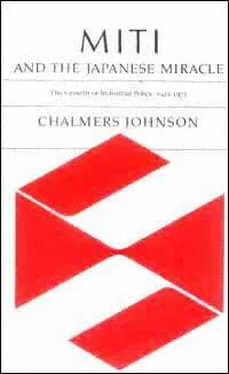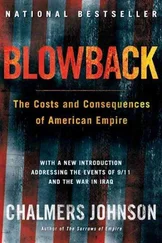Chalmers Johnson - MITI and the Japanese miracle
Здесь есть возможность читать онлайн «Chalmers Johnson - MITI and the Japanese miracle» весь текст электронной книги совершенно бесплатно (целиком полную версию без сокращений). В некоторых случаях можно слушать аудио, скачать через торрент в формате fb2 и присутствует краткое содержание. Год выпуска: 2007, Издательство: Stanford University Press, Жанр: Старинная литература, на английском языке. Описание произведения, (предисловие) а так же отзывы посетителей доступны на портале библиотеки ЛибКат.
- Название:MITI and the Japanese miracle
- Автор:
- Издательство:Stanford University Press
- Жанр:
- Год:2007
- ISBN:нет данных
- Рейтинг книги:3 / 5. Голосов: 1
-
Избранное:Добавить в избранное
- Отзывы:
-
Ваша оценка:
- 60
- 1
- 2
- 3
- 4
- 5
MITI and the Japanese miracle: краткое содержание, описание и аннотация
Предлагаем к чтению аннотацию, описание, краткое содержание или предисловие (зависит от того, что написал сам автор книги «MITI and the Japanese miracle»). Если вы не нашли необходимую информацию о книге — напишите в комментариях, мы постараемся отыскать её.
MITI and the Japanese miracle — читать онлайн бесплатно полную книгу (весь текст) целиком
Ниже представлен текст книги, разбитый по страницам. Система сохранения места последней прочитанной страницы, позволяет с удобством читать онлайн бесплатно книгу «MITI and the Japanese miracle», без необходимости каждый раз заново искать на чём Вы остановились. Поставьте закладку, и сможете в любой момент перейти на страницу, на которой закончили чтение.
Интервал:
Закладка:
Although SCAP's accounts are virtually silent on the subject, the Japanese characterize the first four years of the occupation by reference to two great debates over Japan's economic reconstruction and by one overwhelming factthe rise of the state as the central actor in the economy. The first of the two controversies was over whether reconstruction should give priority to expanding production (the
seisan
fukko
*
setsu
, or the theory of reconstruction through production) or to price stabilization and control of inflation (the
tsuka
*
kaikaku setsu
, or the theory of currency reform).
34
The second controversy concerned
Page 176
what type of economy Japan should rebuildone oriented to light industries and Japan's comparative advantage of a large, still cheap labor force, or one oriented to heavy and chemical industries with their greater value-added potential (that is, the greater value of the products produced after the cost of materials, taxes, and depreciation have been subtracted).
The emphasis on production rather than stabilization and on heavy industry rather than light industry usually prevailed, but the advocates of the opposite positions were not necessarily wrong. They made their contribution during the "Dodge Line" (194950) and the Korean War (195053), when the advocates of production and of heavy industries had to come to grips with controlling inflation and with Japan's dependence on international trade. It was then that MITI was born and that both sides of the occupation controversies were synthesized to form the high-growth system.
The rise of state power and its role in reconstruction dominated all of the controversies. The historian Hata Ikuhiko states flatly that "never has the Japanese bureaucracy exercised greater authority than it did during the occupation"; and the MITI Journalists' Club refers to the occupation as MCI's "golden era"the period in which it exercised total control of the economy.
35
The government's assumption of all functions previously shared with the private sector, its recreation of the ''economic general staff" and the materials mobilization plans under new names but in much stronger forms, and its enactment of legislation that made the National General Mobilization Law pale by comparison led to an enormous growth of the bureaucracy. During 1948 and 1949 MCI came to control the third largest share of the general account budget (only the Prime Minister's office and the Ministry of Finance had larger shares); and when MITI was founded in 1949, it had a total of 21,199 employees, as compared with 13,891 in 1974 to serve an infinitely larger and more complex economy.
The growth of the public sector caused an intensification of the bureaucratic struggles for jurisdiction on which a ministry's security and even its existence depended. The Finance Ministry and the Bank of Japan fought tooth and nail over control of the banks, a struggle that Finance eventually won. Ichimada Naoto was president of the Bank of Japan and an advocate of both the currency reform theory and light industries; had he instead of Ikeda Hayato accepted Prime Minister Yoshida's offer to become minister of finance in 1949, the economic history of postwar Japan would surely have been very different from what it was.
36
But the struggle of greatest interest to this study occurred between the Ministry of Foreign Affairs and MCI. With all of
Page 177
Japan's foreign legations closed, there existed during the occupation a vast surplus of diplomats who had to be given work in the government. They were, moreover, of all officials the most adept at the English language, and this gave them a great advantage in dealing with SCAP.
Most important in this struggle was the fact that the key politician of the postwar years, Prime Minister Yoshida, was an ex-Foreign Office official. Yoshida has always acknowledged that he did not know much about and was more or less uninterested in economics, but he had quite firm views on certain other matters about which he knew a great deal. Two such issues concerned Japan's wartime controlled economy and the economic bureaucrats who had cooperated with the military. He deeply disliked both of them. According to many accounts, Yoshida "could not distinguish an MCI official from an insect"; and he was determined to put reliable Foreign Office men over what he regarded as the dangerously national socialist MCI bureaucrats.
37
MCI had to move nimbly in order to survive at all, since its greatest danger came not from SCAP but from its own country's political leader and from some of his official colleagues. As we shall see, MITI did not escape fully from Foreign Ministry influence until 1956.
In these important bureaucratic struggles, SCAP was not so much "supreme" as a major player on a national chessboard, sometimes the queen but more often merely a pawn. Yoshida on occasion manipulated the purge apparatus to get rid of a politician who had crossed him. And MCI men took full advantage of the proclivities of some of SCAP's "new dealers" toward a "planned economy," much to Yoshida's irritation. The coming to power in 1947 of Japan's only socialist government, something that SCAP was very enthusiastic about, was a godsend for MCInot because MCI advocated socialism but because socialism afforded it a plausible cover for its own industrial policies and because the socialist government put Yoshida out of power for eighteen months.
38
These are matters to which we shall return. The first four years of the occupation were a period of immense complexity, extremely rapid social change, and for the Japanese people a bitter struggle for survivalthe time of the "prison of hunger," as they spoke of it then. But out of it came a summing up of the experiences of the prewar, wartime, and occupation industrial policies that allowed the government during the next decade to lead the country to prosperity.
The initial postwar problem, and the one that conditioned all the others to come, was inflation. If we take the price level of August 1945 to be 100, then the level rose to 346.8 in September, to 584.9 in Decem-
Page 178
ber, and to 1184.5 the following March.
39
Several factors caused this inflation, including mustering-out payments to the Japanese armed forces, but the most important was the continuation and even acceleration of government disbursements for wartime contracts, war production loans, munitions companies guarantees and indemnities, and various other obligations the government had assumed under wartime laws and ordinances. One of these was payments for factories that had been seized and converted to munitions production by the Industrial Facilities Corporation. In mid-1946, when SCAP's order to the government to default on its wartime obligations was finally carried out, the Industrial Facilities Corporation still owed the cotton textile industry some ¥12 billion for factories it had taken over. Before SCAP stopped the payments, the government had literally flooded the economy with money. The
Mainichi
estimates that in a little over three months after the surrender, the government paid out some ¥26.6 billion, a truly colossal sum amounting to about one-third of the total amount Japan had spent for military purposes between September 1937 and August 1945.
40
During 1946 these disbursements led to one of the first big clashes between SCAP and the Japanese over economic policy. Ishibashi Tanzan, minister of finance in the first Yoshida cabinet (May 1946 to May 1947), was a strong advocate of increased production; he boldly argued that "the current economic crisis is not one of inflation but rather of a surplus of unused labor and production facilities. The only way to get out of it is to increase production."
Читать дальшеИнтервал:
Закладка:
Похожие книги на «MITI and the Japanese miracle»
Представляем Вашему вниманию похожие книги на «MITI and the Japanese miracle» списком для выбора. Мы отобрали схожую по названию и смыслу литературу в надежде предоставить читателям больше вариантов отыскать новые, интересные, ещё непрочитанные произведения.
Обсуждение, отзывы о книге «MITI and the Japanese miracle» и просто собственные мнения читателей. Оставьте ваши комментарии, напишите, что Вы думаете о произведении, его смысле или главных героях. Укажите что конкретно понравилось, а что нет, и почему Вы так считаете.












